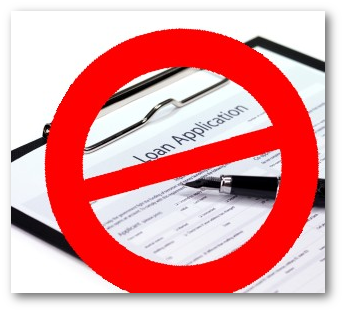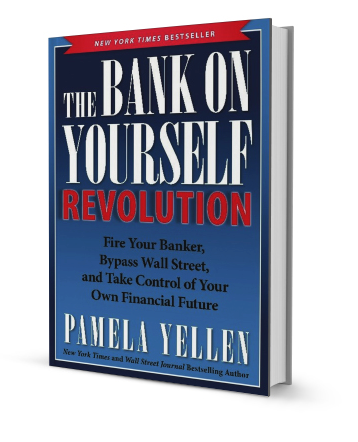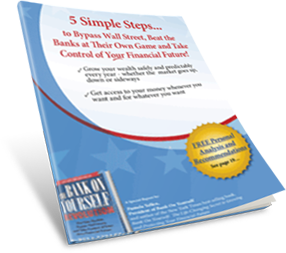Why should you be extremely wary if you’re considering getting cash by tapping your 401(k) plan? Typically, 401(k) loans mire you in red tape, with “gotcha” fine print and some requirements that may be impossible for you to meet. Life insurance policy loans, on the other hand, are easy. They put repayment entirely in your hands. And they give you the opportunity to grow your money even while you borrow it.
To boost the appeal of 401(k) accounts as retirement plans, Wall Street and many employers promote 401(k) loans as a great source of easy money. But while 401(k) loans may be a source of money, they’re not great, and they’re not easy.
In tight times and with stock market values at dizzying heights, many people instinctively look at what seems to be a mountain of money sitting in their 401(k) account and think about borrowing it. Some folks may forget that one of the many restrictions on 401(k) loans is that you can only borrow 50% of your account value, up to a maximum of $50,000.
But even though the government has limited your ability to borrow larger amounts, there are still serious hazards to 401(k) loans.
Marlene had a decent job as an administrative assistant. When she saw the brown stain on her living room ceiling early one fall, she knew her worst fears about her roof were true. It needed to be replaced – now, before the next storm.
Fortunately, her 401(k) plan came to the rescue, and she borrowed the $20,000 she needed to get the work done. The roof was in place within two weeks. But then Marlene got some terrible news. She and several others in her department at work were being let go.
Worse, her 401(k) loan of $20,000 would need to be repaid within 60 days. With no job, that was impossible. Marlene ended up owing income tax on the $20,000, plus a 10% penalty – $2,000 – and Uncle Sam wanted all of that by April 15, just five short months away.
Pitfalls of 401(k) loans
Nerd Wallet reported several 401(k) loan pitfalls in their July 2017 article, “The Astonishingly High Risk of a 401(k) Loan”:
- If you stop making contributions while you repay your loan and you’re in your 30s, a $10,000 loan could cost you $1,000 every month in future retirement income. If you’re in your 20s, that loss could become $2,000 per month!
- If you can’t repay your loan for any reason, you’ll likely trigger taxes and penalties, plus you’ll lose that retirement income.
By the way, don’t think for a moment you can beat the penalties and taxes by simply turning your 401(k) loan into a 401(k) withdrawal. That just makes things worse. Generally speaking, you’ll pay taxes and penalties on all withdrawals you make before age 59½.
While Nerd Wallet did an excellent job of pointing out two of the pitfalls of 401(k) loans, the fact is I’ve been warning of the hazards of 401(k) loans and explaining the advantages of cash value life insurance policy loans for ages.
For example, in my New York Times best-selling book, The Bank On Yourself Revolution, first published back in 2014, I was already talking about the Harvard economist whose research revealed that fully 15% of 401(k) loans go into default.
And at least 75% of workers who leave their jobs with a loan outstanding end up defaulting and getting stuck paying penalties and taxes. (That’s what happened to Marlene.)
Even the IRS warns about some of the pitfalls of 401(k) account loans:
If you don’t repay the loan, including interest, according to the loan’s terms, any unpaid amounts become a plan distribution to you. You will be required to repay the loan in full – with interest – if you leave your job for any reason, even if you got fired or laid off.
Generally, you have to include any previously untaxed amount of the distribution in your gross income in the year in which the distribution occurs. You may also have to pay an additional 10% tax on the amount of the taxable distribution, unless you:
- are at least age 59 ½, or
- qualify for another exception
Any unpaid loan amount also means you’ll have less money saved for your retirement.
Summary of Seven 401(k) Loan Problems
Before we look at the solution, let’s quickly summarize the seven biggest problems with 401(k) loans:
- Even applying for a 401(k) loan can be a complicated process, including notarized signatures, promissory notes, irrevocable pledges, and an assignment of assets
- It can take weeks for your check to arrive – if the committee decides you deserve the loan
-
The government tells you what you can use the money for, how much you can borrow, how long you can borrow it for, and how you must pay it back
Example: You’ll have a maximum of five years to repay most 401(k) plan loans. That means if you want to borrow $40,000 to help finance your child’s college education, you’ve got to pay it back in five short years
- They won’t let you borrow more than 50% of your account balance, and never more than $50,000, no matter how much you have in your account
-
If you’re 90 days late on a payment, the entire outstanding balance is considered a distribution. That means you’ll pay income tax on the balance you still owe, plus a 10% penalty if you’re under 59½
So, if you borrow $50,000 and something dreadful happens, 90 days later you’ll be hit with a $5,000 penalty, plus an income tax bill of probably $12,500 or more – for a total of $17,500 due next April 15
-
Your plan’s balance can stagnate if you take out a 401(k) loan.
For example, here’s a thirty-five-year-old with $20,000 in her plan. She takes out two 401(k) loans in fifteen years – and ends up with $38,000 less at age sixty-five, even if the loans are repaid without penalty. (Source: New York Times)
- Some 401(k) plans won’t let you make any contributions while making loan payments. Others make you wait a set time before contributing again after taking a withdrawal. If your employer matches your contributions, you’ll take a double hit
Get instant access to the FREE 18-page Special Report that reveals how super-charged dividend paying whole life insurance lets you bypass Wall Street, fire your banker, and take control of your financial future.
Get instant access to the FREE 18-page Special Report that reveals how super-charged dividend paying whole life insurance lets you bypass Wall Street, fire your banker, and take control of your financial future.
Life Insurance Policy Loans to the Rescue
When you’re strapped for cash, a much better alternative than a 401(k) loan is to tap into the living benefits of your Bank On Yourself-type dividend-paying whole life insurance policy or other cash value life insurance policy.
Cash value life insurance policies have living benefits, which means, among other things, that as you pay your policy premiums, you build up a pool of cash you can access with no income taxes due. The most common way to access that cash before retirement is with a life insurance loan.
Eight Benefits of a Life Insurance Policy Loan
- With Bank On Yourself-type life insurance policy loans, no loan application is required. You can literally get your hands on the money you need from your policy within days of applying for your life insurance loan

- Just call or send an email to the life insurance company and tell them how much money you want and where to send it, and they’ll send it! It sounds easy because it is easy
- You can borrow your equity (cash value) whenever you want, for whatever you want, with no government restrictions – no penalties for early withdrawals, late withdrawals, or no withdrawals
- You have full access to 85% or more of the cash value of your policy beginning the very first month, without selling your assets for a life insurance loan
- In fact, when you borrow money, your policy can continue growing, just as if you hadn’t touched a dime of it – if your policy is from one of the handful of companies that offers this feature. (If it’s hard to wrap your head around that concept, a Bank On Yourself Professional will be happy to explain)
-
You decide if and when to repay your life insurance policy loan. (Your Bank On Yourself Professional will recommend that you plan to repay your loan – unless you’ve borrowed to create a retirement income stream – to keep your policy from lapsing, and to replenish your cash availability for the next time you need money)
Your life insurance loan will continue to accrue interest on the unpaid balance, and when you pass away, the interest and unpaid balance will be deducted from the amount your beneficiaries receive from your life insurance policy. But if your interest and unpaid balance ever grow so large that they threaten to exceed your policy’s cash value, your policy could lapse. So you and your advisor will want to watch that carefully.
Still, if you have a down month or two, or six, you can skip a few payments. It’s your schedule. And there are no taxes, penalties, or fees for doing that. (This would have been perfect for Marlene.)
- A life insurance policy loan isn’t taxable, and there’s no impact on your credit rating
- Your loan absolutely will not affect the growth of your policy (assuming it’s from one of a handful of life insurance companies that offers this feature), even if you don’t make your payments when you thought you would
You’ll still get the same guaranteed cash value increase and the same dividends you would have received if you didn’t have a loan. To learn more about this amazing and valuable feature, take a look at How Bank On Yourself Whole Life Insurance Policy Loans Work.
Your Next Step if You’re Considering a 401(k) Loan or a Life Insurance Policy Loan
Get instant access to the FREE 18-page Special Report that reveals how super-charged dividend paying whole life insurance lets you bypass Wall Street, fire your banker, and take control of your financial future.
There are times when you simply must have the money. It’s time to replace the roof. Your washing machine just washed its last load, the dentist says it’ll cost $10,000 to fix those chompers.
But you don’t have to pay finance company or bank loan rates for that new roof, new washer, or new smile! And you certainly don’t have to take the risks that come with a 401(k) loan. With some advance planning and preparation, you can actually bank on yourself.
Think of being able to tell your banker or 401(k) loan committee to go take a hike! Wouldn’t you prefer a loan without government restrictions, and with the privacy of not having to discuss your financial needs with your employer or some loan committee?
Imagine how empowering it will feel to be able to handle it all yourself!
We’ve given you just a few benefits of Bank On Yourself life insurance policy loans. They’re just the tip of the iceberg! In early 2017, we invited our readers to share their personal experiences with Bank On Yourself policy loans versus other sources of financing. Check out “21 Reasons Life Insurance Policy Owners Love the Policy Loan Feature.”
Get instant access to the FREE 18-page Special Report that reveals how super-charged dividend paying whole life insurance lets you bypass Wall Street, fire your banker, and take control of your financial future.
Next steps to take to become your own source of financing and avoid the pitfalls of 401(k) loans
Get all the facts before you get the cash. Download our Free Special Report right now: 5 Simple Steps to Bypass Wall Street, Beat the Banks at Their Own Game and Take Control of Your Financial Future. It will give you an overview of the Bank On Yourself strategy and help you see possibilities you may never have thought of before.
Then, after you’ve reviewed the report, request a FREE Bank On Yourself Analysis. You’ll get a referral to one of only 200 advisors in the US and Canada who have met the rigorous training and requirements to be Bank On Yourself Professionals. Your advisor will look at your overall financial picture to find creative ways to solve your immediate need for cash and help you create a plan so that you never again need to consider the possibility of taking out a risky 401(k) policy loan – or a loan from any other outside financial source!



